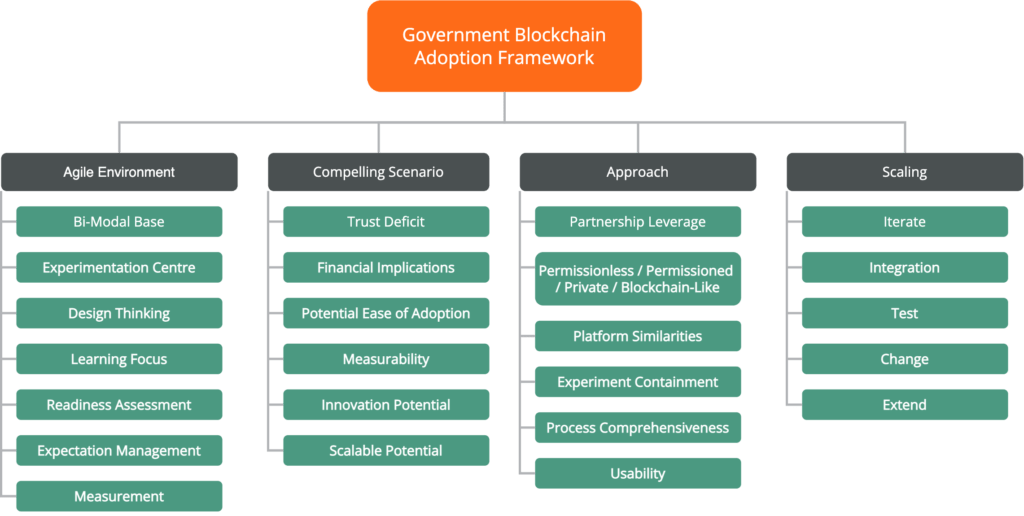Amid all the hype and hope around the potential for blockchain to restore trust in government and revolutionize citizen service delivery the reality is that not all governments are ready to adopt these technologies.
What Are The Benefits of Blockchain in Government?
As an enabler of good governance, blockchain can help governments to improve trust through:
- Corruption reduction: Blockchain mechanisms for digital identity and transaction encryption can reduce procurement, human resources, taxation, land title, healthcare, education, and voting fraud
- Financial inclusion: Blockchain integrated with mobile devices can help bank the unbanked, support microfinancing and remittances, provide payments to refugees
- Efficiency improvements: Blockchain integrated with back-office government systems can facilitate debt, investment, and payment contract management
How to Implement Blockchain in Government
Blockchain adoption is in some ways like any other digital transformation in government. However, it requires a far higher state of readiness than the implementation of a Financial Management Information System (FMIS) such as the FreeBalance Accountability Suite™. To help governments to determine their readiness for blockchain adoption and to design a roadmap for implementation, FreeBalance has developed an adoption framework.

Unpacking the Government Blockchain Adoption Framework
FreeBalance’s Government Blockchain Adoption Framework consists of the following:
Agile Environment
Governments with agile capabilities can optimize results from blockchain initiatives:
- Bi-Modal Base
- Process, controls, and information governance are more flexible in agile than traditional IT, so governments need to support bi-modal or multi-modal approaches to support traditional IT governance for core systems, as well as agile governance for blockchain
- Experimentation Centre
- Governments need innovation and experimentation centres to provide new perspectives and encourage creativity
- Design Thinking
- Design thinking approaches focuses teams on problems, and engages users into uncovering solutions
- Learning Focus
- The focus, especially of initial projects, must be to learn through doing and getting user feedback
- Readiness Assessment
- Any digital transformation project, like blockchain, should be contemplated only when project team members have agile skill sets
- Expectation Management
- Stakeholder expectations need to be set, including the notion that many ideas will prove unworkable, but that overall costs will be lower because of agile feedback loops
- Measurement
- Agile methods of measurement provides project teams and stakeholders with progress information, while improving implementation predictability
Compelling Scenario
Governments select compelling ideas for experimentation:
- Trust Deficit
- Scenarios that address trust concerns among stakeholders are likely to have more impact
- Financial Implication
- Rather than a business case that focuses on expected returns, scenarios can be selected based on the financial size of the problem such as tax avoidance estimates, or remittances intermediary costs
- Potential Ease of Adoption
- Stakeholders should be predisposed to solving underlying problems, or aspiring to improved controls
- Measurability
- Prototypes and proofs-of-concept need output and outcome measurements designed ahead of time, and the definition of what success looks like
- Innovation Potential
- Innovation aspirations need to align with innovation capabilities, although there are often opportunities for technology leapfrog
- Scalable Potential
- There should be sufficient anecdotal and case study validation that selected blockchain scenarios could scale
Approach
Governments approach blockchain initiatives based on context to optimize results:
- Partnership Approach
- Governments consider innovative business partners who guide project teams through processes, help identify scenarios, and provide technology insight
- Permission-less / Permissioned / Private / Blockchain-Like
- Distributed ledger concepts should be aligned to scenarios, although proofs-of-concepts may adjust thinking and the need for tokens and token mining is likely unnecessary for most government scenarios
- Platform Similarities
- It is difficult to predict which platforms will dominate blockchain implementations in the future, so governments should begin experiments with platforms that have shown some success in similar scenarios
- Experimentation Containment
- Experimentation scope needs to be manageable by reducing potential external factors
- Process Comprehensiveness
- Process scope needs to be sufficiently complete to prove or disprove experiments, such as handling multiple step workflows
- Usability
- Usability needs to be addressed through prototyping sessions to ensure that experiments do not fail because systems were too difficult to use
Scaling
Governments use learning in prototypes and proofs-of-concept to scale blockchain initiatives successfully:
- Iterate
- Successful proofs-of-concept will have feedback to enable improvement before implementing in production
- Integration
- Integration with dependent subsystems needs to become seamless
- Test
- Load, regression and security testing is required before production
- Change
- Design thinking initiates organizational change by involving stakeholders, comprehensive change programs are necessary for blockchain in production
- Extend
- Technologies used in any successful blockchain project could extend to similar scenarios
Get in touch to find out more about FreeBalance’s Blockchain Advisory Services
